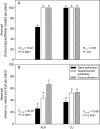Variation of pollinator assemblages and pollen limitation in a locally specialized system: the oil-producing Nierembergia linariifolia (Solanaceae)
- PMID: 18765440
- PMCID: PMC2712377
- DOI: 10.1093/aob/mcn154
Variation of pollinator assemblages and pollen limitation in a locally specialized system: the oil-producing Nierembergia linariifolia (Solanaceae)
Abstract
Background and aims: Few studies have examined the dynamics of specialist plant-pollinator interactions at a geographical scale. This knowledge is crucial for a more general evolutionary and ecological understanding of specialized plant-pollinator systems. In the present study, variations in pollinator activity, assemblage composition and pollen limitation were explored in the oil-producing species Nierembergia linariifolia (Solanaceae).
Methods: Pollen limitation in fruit and seed production was analysed by supplementary hand pollination in five wild populations. Pollinator activity and identity were recorded while carrying out supplementary pollination to assess the effect of pollinators on the degree of pollen limitation. In two populations, pollen limitation was discriminated into quantitative and qualitative components by comparing supplementation and hand cross-pollination in fruit set and seed set. The effect of flower number per plant on the number of flowers pollinated per visitor per visit to a plant was examined in one of these populations as a possible cause of low-quality pollination by increasing geitonogamy.
Results and conclusions: Although pollen limitation was evident along time and space, differences in magnitude were detected among populations and years that were greatly explained by pollinator activity, which was significantly different across populations. Floral display size had a significant effect on the visitation rate per flower. Limitation by quality clearly affected one population presumably due to a high proportion of geitonogamous pollen. The great inter-population variation in plant-pollinator interaction (both in pollinator assemblages composition and pollinator activity) and fitness consequences, suggests that this system should be viewed as a mosaic of locally selective processes and locally specialized interactions.
Figures






Similar articles
-
Sources of variation in pollinator contribution within a guild: the effects of plant and pollinator factors.Oecologia. 1996 Sep;107(4):595-604. doi: 10.1007/BF00333953. Oecologia. 1996. PMID: 28307405
-
Sterile flowers increase pollinator attraction and promote female success in the Mediterranean herb Leopoldia comosa.Ann Bot. 2013 Jan;111(1):103-11. doi: 10.1093/aob/mcs243. Epub 2012 Nov 6. Ann Bot. 2013. PMID: 23131298 Free PMC article.
-
Pollinator-mediated selection in a specialized pollination system: matches and mismatches across populations.J Evol Biol. 2010 Sep 1;23(9):1957-68. doi: 10.1111/j.1420-9101.2010.02060.x. Epub 2010 Jul 31. J Evol Biol. 2010. PMID: 20695967
-
Mechanisms and evolution of deceptive pollination in orchids.Biol Rev Camb Philos Soc. 2006 May;81(2):219-35. doi: 10.1017/S1464793105006986. Biol Rev Camb Philos Soc. 2006. PMID: 16677433 Review.
-
Pollinator, pollen, and cultivar identity drive crop quality.Trends Plant Sci. 2025 Mar;30(3):283-290. doi: 10.1016/j.tplants.2024.10.004. Epub 2024 Nov 1. Trends Plant Sci. 2025. PMID: 39488476 Review.
Cited by
-
Elevational and temporal patterns of pollination success in distylous and homostylous buckwheats (Fagopyrum) in the Hengduan Mountains.Plant Divers. 2023 Oct 19;46(5):661-670. doi: 10.1016/j.pld.2023.10.001. eCollection 2024 Sep. Plant Divers. 2023. PMID: 39290890 Free PMC article.
-
On 'various contrivances': pollination, phylogeny and flower form in the Solanaceae.Philos Trans R Soc Lond B Biol Sci. 2010 Feb 12;365(1539):449-60. doi: 10.1098/rstb.2009.0236. Philos Trans R Soc Lond B Biol Sci. 2010. PMID: 20047871 Free PMC article.
-
Extreme variation in floral characters and its consequences for pollinator attraction among populations of an Andean cactus.Ann Bot. 2009 Jun;103(9):1489-500. doi: 10.1093/aob/mcp075. Epub 2009 Apr 2. Ann Bot. 2009. PMID: 19342397 Free PMC article.
-
Pollen limitation in a narrow endemic plant: geographical variation and driving factors.Oecologia. 2012 Oct;170(2):421-31. doi: 10.1007/s00442-012-2312-1. Epub 2012 Apr 11. Oecologia. 2012. PMID: 22492167
-
Geographical differentiation in floral traits across the distribution range of the Patagonian oil-secreting Calceolaria polyrhiza: do pollinators matter?Ann Bot. 2014 Jan;113(2):251-66. doi: 10.1093/aob/mct239. Epub 2013 Nov 18. Ann Bot. 2014. PMID: 24252281 Free PMC article.
References
-
- Ackerman JD, Montalvo AM. Short-and long-termed limitations to fruit production in a tropical orchid. Ecology. 1990;71:263–272.
-
- Ǻgren J. Population size, pollinator limitation, and seed set in the self-incompatible herb Lythrum salicaria. Ecology. 1996;77:1779–1790.
-
- Aizen M, Harder LD. Expanding the limits of the pollen-limitation concept: efects of pollen quantity and quality. Ecology. 2007;88:271–281. - PubMed
-
- Ashman TL, Knight TM, Steets JA, Amarasekare P, Burd M, Campbell D, et al. Pollen limitation of plant reproduction: ecological and evolutionary causes and consequences. Ecology. 2004;85:2408–2421.

